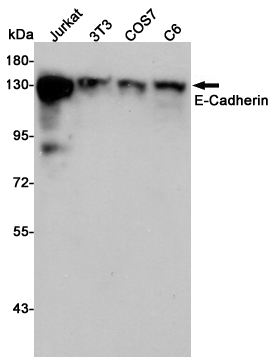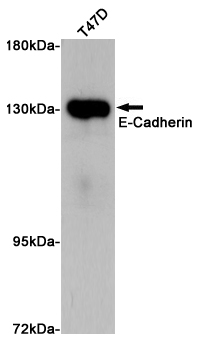

| WB | 咨询技术 | Human,Mouse,Rat |
| IF | 咨询技术 | Human,Mouse,Rat |
| IHC | 1/50-1/100 | Human,Mouse,Rat |
| ICC | 1/50-1/200 | Human,Mouse,Rat |
| FCM | 咨询技术 | Human,Mouse,Rat |
| Elisa | 1/10000 | Human,Mouse,Rat |
| Aliases | CDH1; CDHE; UVO; Cadherin-1; CAM 120/80; Epithelial cadherin; E-cadherin; Uvomorulin; CD antigen CD324 |
| Entrez GeneID | 999 |
| WB Predicted band size | Calculated MW: 97 kDa; Observed MW: 125-130 kDa |
| Host/Isotype | Rabbit IgG |
| Antibody Type | Primary antibody |
| Storage | Store at 4°C short term. Aliquot and store at -20°C long term. Avoid freeze/thaw cycles. |
| Species Reactivity | Human,Mouse,Rat |
| Immunogen | The antiserum was produced against synthesized peptide derived from human Cadherin. AA range:833-882 |
| Formulation | Purified antibody in PBS with 0.05% sodium azide,0.5%BSA and 50% glycerol. |
+ +
以下是关于E-Cadherin抗体的3篇参考文献,按文献名称、作者和摘要内容简要列举:
---
1. **文献名称**: "The E-cadherin/catenin complex in invasion and metastasis of human carcinomas"
**作者**: Berx, G., & van Roy, F.
**摘要**: 该综述探讨了E-Cadherin在癌症转移中的作用,强调其通过细胞间黏附抑制肿瘤侵袭。文献总结了E-Cadherin表达缺失与上皮间质转化(EMT)的相关性,并提及抗体在检测肿瘤组织中E-Cadherin蛋白水平中的应用(如免疫组化),为癌症预后评估提供依据。
---
2. **文献名称**: "E-cadherin: Its role in embryonic stem cell pluripotency and cancer progression"
**作者**: Nollet, F., et al.
**摘要**: 研究分析了E-Cadherin在维持胚胎干细胞多能性和肿瘤转移中的双重作用,重点通过抗体阻断实验证明E-Cadherin缺失会破坏细胞间连接,促进癌细胞迁移。抗体被用于体外功能实验(如流式细胞术和Western blot),验证其作为细胞黏附标志物的可靠性。
---
3. **文献名称**: "Epithelial-mesenchymal transitions in development and disease"
**作者**: Thiery, J.P., et al.
**摘要**: 该经典综述系统阐述了EMT在胚胎发育和癌症转移中的机制,指出E-Cadherin下调是EMT的核心标志。文献中多次引用基于E-Cadherin抗体的实验(如免疫荧光染色),用于追踪EMT过程中黏附蛋白的动态变化,并关联其与肿瘤侵袭性的关系。
---
**备注**:以上文献均为领域内经典或高引研究,覆盖E-Cadherin在癌症、干细胞及发育生物学中的功能,并体现了抗体在基础研究与临床诊断中的关键作用。如需具体发表信息(期刊、年份),可进一步补充。
E-cadherin, a calcium-dependent cell adhesion molecule, plays a pivotal role in maintaining epithelial tissue integrity by mediating homophilic cell-cell interactions. As a key component of adherens junctions, it facilitates tissue morphogenesis, polarity, and differentiation through its extracellular domain binding and intracellular linkage to β-catenin and the actin cytoskeleton. Dysregulation of E-cadherin expression is clinically significant, particularly in cancer biology. Its downregulation is strongly associated with epithelial-mesenchymal transition (EMT), a process driving tumor invasion, metastasis, and therapeutic resistance across various carcinomas.
Antibodies targeting E-cadherin have become essential tools in both research and diagnostics. In experimental settings, they enable detection of protein localization via immunohistochemistry (IHC) and quantification through Western blotting, providing insights into cellular junction dynamics. Clinically, these antibodies aid in distinguishing histological subtypes, such as lobular versus ductal breast carcinomas, where E-cadherin loss is a diagnostic hallmark. Recent advancements have improved antibody specificity through validation in knockout cell lines, with clone-dependent variations (e.g., NCH-38. 36/E-cad) showing differential performance across tissue types and fixation methods. Emerging applications include monitoring EMT in therapeutic contexts and investigating cadherin-switching phenomena in tumor microenvironments. Proper validation remains critical, as incomplete E-cadherin loss in some cancers and antibody cross-reactivity with other cadherin family members can complicate interpretation.
×